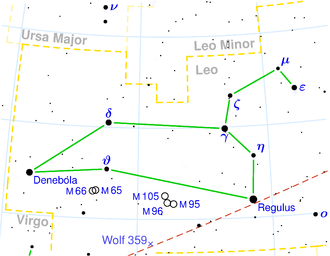NGC 2968
| Galaxy NGC 2968 |
|
|---|---|

|
|
| Image of NGC 2968 (top right) and NGC 2964 (bottom left) with the 81 cm reflecting telescope of the Mount Lemmon Observatory | |
| AladinLite | |
| Constellation | lion |
|
Position equinox : J2000.0 , epoch : J2000.0 |
|
| Right ascension | 09 h 43 m 12 s |
| declination | + 31 ° 55 ′ 43 ″ |
| Appearance | |
| Morphological type | (R) SAB0 (rs) a? / pec |
| Brightness (visual) | 11.9 likes |
| Brightness (B-band) | 12.8 mag |
| Angular expansion | 2.1 ′ × 1.6 ′ |
| Position angle | 45 ° |
| Surface brightness | 13.1 mag / arcmin² |
| Physical data | |
| Affiliation | WBL 235 |
| Redshift | 0.005224 ± 0.000097 |
| Radial velocity | 1566 ± 29 km / s |
|
Stroke distance v rad / H 0 |
(68 ± 5) x 10 6 ly (20.9 ± 1.5) Mpc |
| history | |
| discovery | William Herschel |
| Discovery date | December 7, 1785 |
| Catalog names | |
| NGC 2968 • UGC 5190 • PGC 27800 • CGCG 152-058 • MCG + 05-23-029 • 2MASX J09431201 + 3155438 • GC 1899 • H II 491 • h 624 • GALEX ASC J094312.05 + 315541.9 • LDCE 676 NED002 | |
NGC 2968 is a lenticular galaxy of the Hubble type SB0 / a in the constellation Leo on the ecliptic . It is estimated to be 68 million light years from the Milky Way and about 45,000 light years across. Together with NGC 2964 and NGC 2970 , it forms the isolated galaxy triplet KTG 25 .
In the same area of the sky there is u. a. the galaxy NGC 2981 .
The Type I supernova SN 1970L was observed here.
The object was discovered on December 7, 1785 by the astronomer William Herschel with a 48 cm telescope; the discovery was later recorded in the New General Catalog .
Web links
Commons : NGC 2968 - collection of images, videos, and audio files
